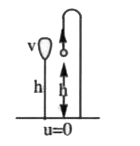A balloon rises rest on the ground with constant acceleration 1ms−2. A stone is dropped when balloon has risen to a height of 39.2m. Find the time taken by the stone to teach the ground.
The correct Answer is:4
To solve the problem, we need to determine the time taken by the stone to reach the ground after being dropped from a height of 39.2 m. The balloon rises with a constant acceleration of 1 m/s².
1. Calculate the velocity of the balloon at 39.2 m height:
We can use the third equation of motion:
v2=u2+2as
Here, u=0 (initial velocity), a=1m/s2 (acceleration), and s=39.2m (height).
v2=0+2×1×39.2
v2=78.4
v=√78.4≈8.86m/s
2. Set up the equation for the stone's motion after being dropped:
When the stone is dropped, it has an initial velocity v (upward) and is at a height of 39.2 m. The equation of motion can be written as:
h=vt−12gt2
Here, h=39.2m, g=9.8m/s2, and v≈8.86m/s.
3. Rearranging the equation:
39.2=8.86t−12⋅9.8t2
Rearranging gives:
4.9t2−8.86t+39.2=0
4. Using the quadratic formula to solve for t:
The quadratic formula is given by:
t=−b±√b2−4ac2a
Here, a=4.9, b=−8.86, and c=39.2.
t=−(−8.86)±√(−8.86)2−4⋅4.9⋅39.22⋅4.9
t=8.86±√78.4−768.169.8
t=8.86±√−689.769.8
Since the discriminant is negative, we must have made a mistake in the setup. Let's correct it.
5. Correcting the equation:
The correct equation should be:
0=4.9t2−8.86t−39.2
Now, applying the quadratic formula:
t=8.86±√(−8.86)2−4⋅4.9⋅(−39.2)2⋅4.9
t=8.86±√78.4+768.169.8
t=8.86±√846.569.8
t=8.86±29.149.8
6. Calculating the two possible values for t:
- Positive root:
t=389.8≈3.88s
- Negative root (not physically meaningful):
t=−20.289.8 (discarded)
7. Final answer:
The time taken by the stone to reach the ground is approximately 3.88s.
We can use the third equation of motion:
v2=u2+2as
Here, u=0 (initial velocity), a=1m/s2 (acceleration), and s=39.2m (height).
v2=0+2×1×39.2
v2=78.4
v=√78.4≈8.86m/s
When the stone is dropped, it has an initial velocity v (upward) and is at a height of 39.2 m. The equation of motion can be written as:
h=vt−12gt2
Here, h=39.2m, g=9.8m/s2, and v≈8.86m/s.
39.2=8.86t−12⋅9.8t2
Rearranging gives:
4.9t2−8.86t+39.2=0
The quadratic formula is given by:
t=−b±√b2−4ac2a
Here, a=4.9, b=−8.86, and c=39.2.
t=−(−8.86)±√(−8.86)2−4⋅4.9⋅39.22⋅4.9
t=8.86±√78.4−768.169.8
t=8.86±√−689.769.8
Since the discriminant is negative, we must have made a mistake in the setup. Let's correct it.
The correct equation should be:
0=4.9t2−8.86t−39.2
Now, applying the quadratic formula:
t=8.86±√(−8.86)2−4⋅4.9⋅(−39.2)2⋅4.9
t=8.86±√78.4+768.169.8
t=8.86±√846.569.8
t=8.86±29.149.8
- Positive root:
t=389.8≈3.88s
- Negative root (not physically meaningful):
t=−20.289.8 (discarded)
The time taken by the stone to reach the ground is approximately 3.88s.
Topper's Solved these Questions
Similar Questions
A balloon rises from rest on the ground with constant acceleration g/8. A stone is dropped from the balloon when the balloon has risen to a height of (H). Find the time taken by the stone to reach the ground.
View SolutionA balloon starts rising from the ground with a constant acceleration of 1.25m/s2. After 8 s, a stone is released from the balloon. Find the time taken by the stone to reach the ground. (Take g=10m/s2)
View SolutionA balloon starts rising from the ground with an acceleration of 1.25 m/s2 . A stone is released from the balloon after 10s. Determine
(1) maximum height of ston from ground
(2) time taken by stone to reach the ground
View SolutionA helicopter rises from rest on the ground vertically upwards with a constant acceleration g. A food packet is dropped from the helicopter when is at a height h. The time taken by the packet to reach the ground is close to [ g is the acceeration due to gravity] :
View SolutionA stone is dropped from a balloon ascending with v0=2ms, from a height h=4.8 m .Find the time of flight of the stone.
View SolutionA balloon starts from rest from the ground and moves with uniform acceleration g/8. When it reaches a height h a ball is dropped from it. Find the time taken by the ball to reach the ground.

View SolutionA balloon rises with uniform velocity of 10ms−1. When the balloon is at a height of 75 m if a stone is dropped from it the time taken by it to reach the ground is
View SolutionA balloon in ascending vertically with an acceleration of 1ms−2. Two stones are dropped from it at an interval of 2s. Find the distance berween them 1.5s after the second stone is released.
View SolutionA packet is dropped from a balloon rising up with uniform velocity 9.8ms−1. If the balloon is at a height of 39.2 m from the ground at the time of dropping the stone, the stone reaches the ground after
View SolutionA balloon starts rising from ground from rest with an upward acceleration 2m/s2. Just after 1 s, a stone is dropped from it. The time taken by stone to strike the ground is nearly
View Solution
